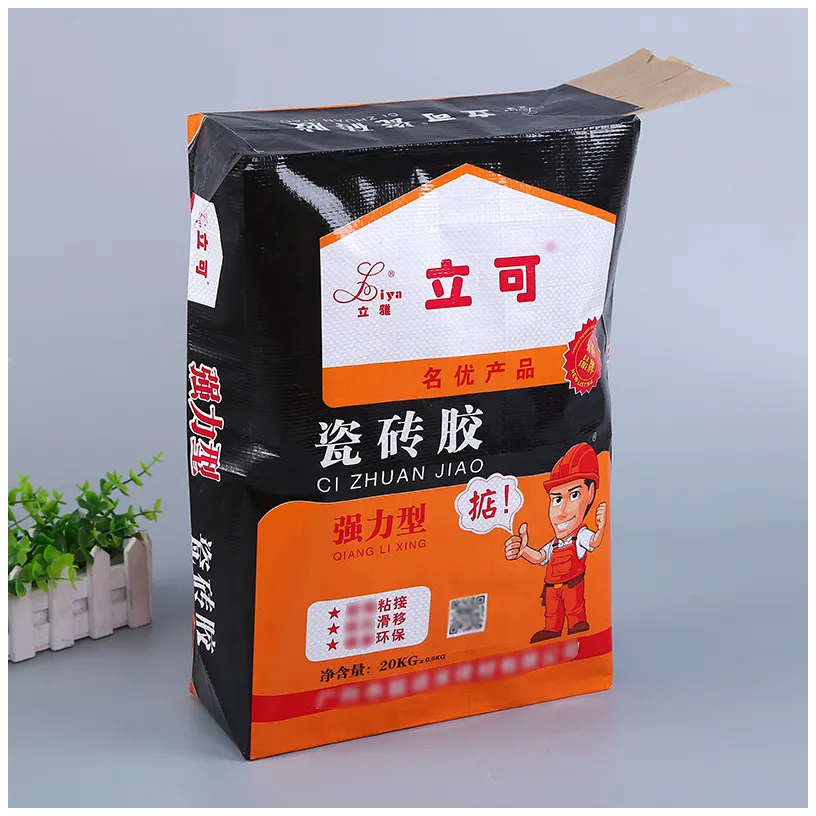
VidePak’s SOS (Self-Opening Sack) PP fabric bags are engineered to withstand the rigors of packaging abrasive, heavy, and fine-powder materials like cement, gypsum, and aggregates. With a tensile strength of 40–60 N/5cm, puncture resistance exceeding 150 N, and leak-proof seams tested under 200 kPa pressure, these bags ensure zero material loss during transport and stacking. By integrating ISO 21898:2020 (EU), ASTM D5635-21 (US), JIS Z1533:2022 (Japan), and AS 4024.4:2022 (Australia) standards, VidePak delivers region-specific solutions—from 80–120 GSM laminated PP fabrics to reinforced valve designs—minimizing waste and maximizing ROI for global construction suppliers.
1. Structural Integrity for Abrasive Materials
The SOS PP fabric bag’s design prioritizes mechanical resilience against sharp-edged aggregates and high-density powders.
1.1 High-Strength PP Weave Architecture
- Yarn Composition: 100% virgin PP monofilaments (denier 1000–1500) with UV stabilizers.
- Weave Density: 12×14 threads/inch, reducing inter-yarn gaps to ≤0.5 mm (vs. 1.2 mm in standard bags).
- Lamination: 20–30 micron BOPP film increases abrasion resistance by 40% (tested per ASTM D5264).
For example, a 50 kg cement bag using VidePak’s 100 GSM PP fabric with 25μ BOPP lamination achieved 1,200+ MIT flex cycles without rupture—exceeding JIS Z1533’s 800-cycle benchmark.
1.2 Anti-Leakage Mechanisms
| Feature | Specification | Application |
|---|---|---|
| Valve Seal | Heat-sealed block-bottom valve (5–7 mm overlap) | Gypsum powder, silica sand |
| Edge Reinforcement | Double-stitched seams with PP tape binding | Sharp aggregates (crushed stone, gravel) |
| Inner Liner | 50μ PE-coated kraft paper (burst strength: 300 kPa) | Fine powders (talc, fly ash) |
A Chilean client reduced cement spillage by 98% after switching to VidePak’s PE-lined SOS bags with laser-calibrated valve tolerances (±0.3 mm).
2. Compliance with Global Standards
Regional regulations dictate material choices and performance thresholds for construction packaging.
2.1 Regional Strength and Durability Requirements
| Standard | Tensile Strength (N/5cm) | Moisture Barrier | Stacking Height |
|---|---|---|---|
| ISO 21898:2020 | ≥45 (warp/weft) | ≤2% water vapor transmission | 8 layers (25 kg/bag) |
| ASTM D5635-21 | ≥50 (warp), ≥40 (weft) | Hydrostatic head ≥4.3 kPa | 10 layers (50 lb/bag) |
| JIS Z1533:2022 | ≥55 (both directions) | Seam leakage ≤0.1 g/min | 7 layers (30 kg/bag) |
| AS 4024.4:2022 | ≥60 (warp), ≥50 (weft) | UV resistance ≥1,500 hrs | 6 layers (40 kg/bag) |
VidePak’s 120 GSM laminated PP bags meet AS 4024.4’s UV requirements via 3% HALS additives, ideal for Australian outdoor storage.
3. Customization for Material-Specific Challenges
3.1 Cement Packaging
- Breathable Design: Micro-perforated vents (0.3–0.5 mm) prevent CO₂ buildup during curing.
- Anti-Caking Liners: 30μ PE film with anti-static coating (surface resistivity: 10¹⁰ Ω/sq).
3.2 Gypsum/Plaster Powder
- Moisture Barrier: Aluminum-PET laminates (OTR <5 cc/m²/day) inhibit premature hardening.
- Dust-Free Filling: Spouted valves with ultrasonic sealing (leak rate <0.05 g/m³).
3.3 Aggregate Packaging
- Abrasion-Resistant Coatings: 50μ PP fabric + 2% silicon dioxide nanoparticles (wear loss <0.8 mg/1,000 cycles, per ASTM D3389).
- Reinforced Bottom Gussets: Triple-layered corners withstand 50+ drops from 1.5 m (ISO 2248).
4. VidePak’s Manufacturing Edge
With 100+ Starlinger circular looms and 16 extrusion lines, VidePak produces 15 million SOS bags monthly:
- Precision Weaving: AI-guided tension control (±2% variation) ensures uniform fabric density.
- Eco-Friendly Production: 25% recycled PP content (GRS-certified) without compromising strength.
- Custom Printing: 8-color flexography with Pantone-matching (±0.5 ΔE) for hazard labels/branding.
5. FAQs: Technical and Procurement Considerations
Q1: How do SOS bags prevent fine powder leakage during pneumatic filling?
A: Our valve designs incorporate 3D-printed inserts (tolerance: ±0.2 mm) and 70 GSM non-woven filters, achieving <0.01% dust emission (tested per EN 15051-2).
Q2: What bag specifications suit tropical climates with high humidity?
A: Opt for 120 GSM PP + 30μ BOPP lamination (MVTR ≤5 g/m²/day) and anti-fungal coatings (JIS Z2801:2010 compliant).
Q3: Can bags withstand -20°C storage without brittleness?
A: Yes. VidePak’s cold-resistant PP blend (with 15% LDPE) maintains flexibility down to -30°C (ASTM D746).
6. References
- VidePak Official Website: PP Woven Bags Manufacturer
- Email: info@pp-wovenbags.com
- Industry Standards: ISO 21898, ASTM D5635, JIS Z1533, AS 4024.4
This article synthesizes technical benchmarks, regional compliance data, and VidePak’s production capabilities to position SOS PP fabric bags as the optimal choice for demanding construction material packaging.